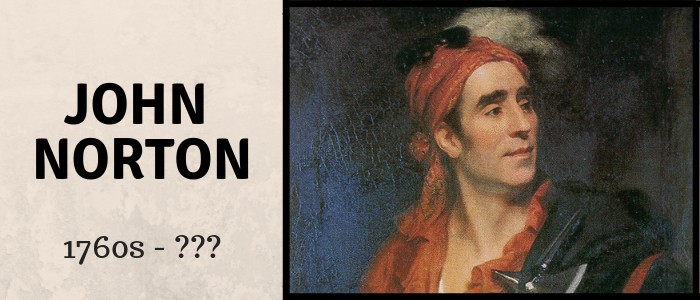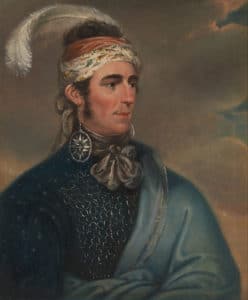John Norton was a Mohawk chief and Iroquois military leader for the British during the War of 1812. Norton was originally from Scotland and was adopted into the Mohawk Indian Tribe.

Commissioned as a major, he led warriors from the Six Nations of the Grand River into battle against American invaders at Queenston Heights, Stoney Creek, and Chippawa.
Early Life

John Norton was born in Scotland to an English mother and an Englishman of Cherokee descent.
His father was taken as a boy by the English after they destroyed his hometown of Keowee during the French and Indian War. The elder Norton was then raised and educated by an English family in Scotland.
He served an apprenticeship as a printer but ran away to join the army. He was assigned to Scotland, where he married.
Next, he was stationed in Ireland, where there were numerous Scots and border English immigrants. In 1785, he was assigned to Lower Canada after the end of the American Revolutionary War.
It was during his deployment to Upper Canada that he deserted the British Army and blended into the Mohawk Indian Tribe. He also traveled throughout the Ohio Valley, making many Native American contacts.
Throughout his travels, he became involved more and more with the Six Nations of the Grand River and became a student of Joseph Brant. Soon, he was adopted into the Mohawk Tribe and considered the nephew of Brant.
Rise in Stature
John Norton was mentored by Joseph Brant and adopted many of his skills. He learned the Mohawk Language and was appointed a "Pine Tree Chief" in a public ceremony. This was an honorary position and was not within a hereditary line.
After the American Revolutionary War, the Mohawk tribe was forced to resettle in Upper Canada. Joseph Brant led those efforts, and Norton aided his efforts. Brant's plan was to lease the land to settlers to develop it.
The Mohawk's plan was not as easy to execute due to the amount of competition from other tribes. The land did not develop rapidly enough, which forced Brant to come up with a different strategy. Brant died in 1807.
During this time, John Norton had left for England to negotiate with the government for Iroquois interests. While in England, he helped translate the Gospel of John into the Mohawk language.
He arrived back in North America and went on another trip to the American Southeast into Cherokee territory. Here, he tried to find his father's family. He did meet some relatives and was accepted as a Cherokee.
War of 1812 and After
After the death of Joseph Brant, John Norton continued to stay active with the Mohawk tribe. Shortly before the War of 1812 officially began, he led a small band of Six Nation warriors into battle at the Battle of Tippecanoe.
When the War of 1812 began, he sided with the British and joined the British General Isaac Brock and Tecumseh at Detroit. His arrival played an important role at the Battle of Queenston Heights.
In 1813, John Norton and his warriors in the British retreat to Burlington Heights after the Americans took control of Fort George. He also provided scouts at the Battle of Stoney Creek and participated in the decisive British victory at the Battle of Beaver Dams.
After the war, he traveled again to the Southeast. Here, he witnessed the final Cherokee golden age. He described their settlements and culture in his journal.
John Norton's name vanishes from history books shortly after his travels. The last mention of him in the records was in 1826. It is unknown when and where he died and where he is buried.
